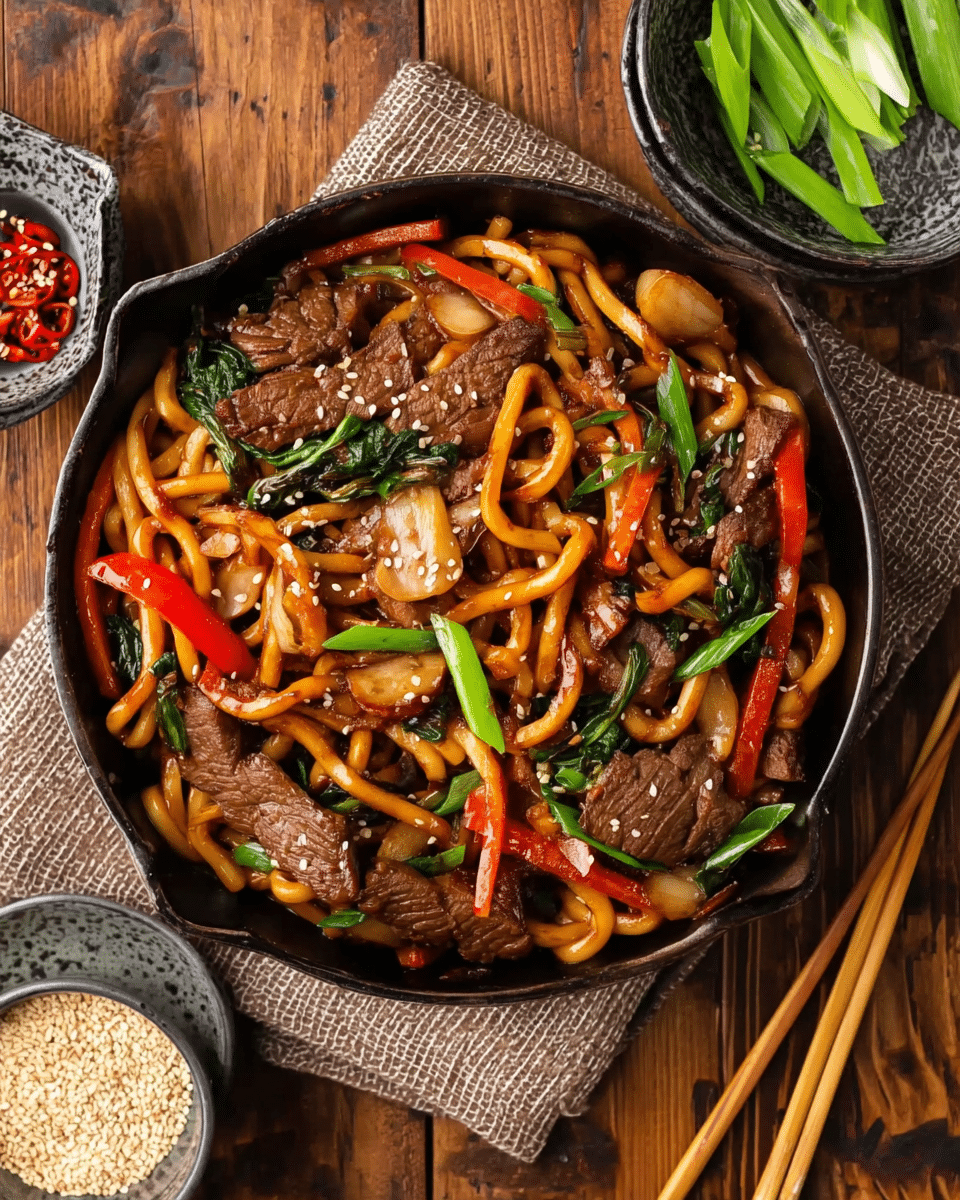Beef Yaki Udon Noodles is a Japanese-inspired stir fry that combines tender slices of steak, chewy udon noodles, and crisp vegetables in a savory-sweet sauce. This one-pan dish is quick to prepare, making it perfect for busy weeknights without sacrificing flavor. With a rich umami sauce and vibrant vegetables, it delivers restaurant-quality taste at home, and it’s easy to customize with your favorite proteins and veggies.
Full Recipe:
Ingredients
-
14 oz udon noodles
-
2 sirloin steaks
-
8 oz baby bok choy, sliced
-
½ cup shiitake mushrooms, sliced
-
2 carrots, sliced
-
5 scallions, cut into 2-inch strips
-
1 tsp baking soda
Sauce:
-
2 tbsp dark soy sauce
-
⅓ cup tamari soy sauce
-
2 tbsp mirin
-
2 tsp brown sugar
-
1 tsp sesame oil
-
1 tbsp cornstarch
Optional Garnish:
-
Japanese red pickled ginger
Directions
-
Make the sauce: In a bowl, whisk together all sauce ingredients until smooth.
-
Prep the beef: Slice steak thinly and toss with salt, pepper, baking soda, and 1 tbsp of the prepared sauce.
-
Blanch the noodles: Place udon in hot water for 2 minutes, drain, rinse well, and set aside.
-
Cook the vegetables: Heat 1 tbsp oil in a wok, add vegetables, and stir fry for 5 minutes. Push veggies to the sides of the wok.
-
Cook the steak: Add steak to the center of the wok and stir fry for 2 minutes.
-
Finish the stir fry: Add noodles and sauce, tossing gently to coat. Cook for 5 minutes until heated through.
-
Serve: Top with red pickled ginger if desired and serve immediately.
Nutrients (per serving – 4 servings)
-
Calories: 388 kcal
-
Carbohydrates: 55 g
-
Protein: 30 g
-
Total Fat: 6 g
-
Saturated Fat: 1 g
-
Polyunsaturated Fat: 0.5 g
-
Monounsaturated Fat: 2 g
-
-
Cholesterol: 46 mg
-
Sodium: 2160 mg
-
Potassium: 449 mg
-
Fiber: 5 g
-
Sugar: 11 g
-
Vitamin A: 5179 IU
-
Vitamin C: 20 mg
-
Calcium: 82 mg
-
Iron: 2 mg
The Star of the Dish: Udon Noodles
Udon noodles are one of Japan’s most beloved staples, known for their plump, chewy texture and mild flavor. They act as the perfect canvas for bold sauces, absorbing the savory-sweet flavors while still maintaining their signature bite. Fresh udon has a soft, pliable texture right out of the package, but even frozen or vacuum-packed udon can be revived with a quick blanch in hot water. In Beef Yaki Udon, the noodles become the unifying element, tying together the richness of the beef, the freshness of the vegetables, and the depth of the sauce.
Choosing the Right Beef
The beef in this dish is more than just a protein—it’s a source of rich, meaty umami that complements the sweet and salty sauce. Sirloin steak is an excellent choice because it’s tender yet flavorful, but other cuts like ribeye or flank steak can work just as well. Thin slicing is key, allowing the meat to cook quickly while staying juicy. Marinating it briefly in a portion of the sauce helps tenderize the beef and infuse it with flavor before it hits the wok.
A Sauce with Layers of Flavor
The sauce is the heart of any stir fry, and this one combines Japanese pantry essentials for a perfect balance of salty, sweet, and savory. Dark soy sauce gives a deep, robust color and flavor, while tamari soy sauce adds umami without overpowering saltiness. Mirin introduces a gentle sweetness and a subtle tang, and brown sugar adds depth to the sweetness while helping create a glossy coating on the noodles. Sesame oil contributes a nutty aroma, and cornstarch thickens the sauce so it clings to every strand of udon and bite of beef.
The Role of Vegetables
The vegetables in Beef Yaki Udon do more than add color—they bring freshness, texture, and nutritional balance. Baby bok choy offers a crisp bite and a mild, slightly peppery taste, while shiitake mushrooms add an earthy richness that deepens the umami profile of the dish. Carrots provide natural sweetness and a vibrant orange hue, and scallions contribute a fresh, aromatic finish. The combination ensures every forkful has a variety of flavors and textures, keeping the dish satisfying from the first bite to the last.
The Cooking Process and Texture Harmony
One of the defining features of Yaki Udon is its textural harmony. The noodles must remain tender yet chewy, the beef seared and juicy, and the vegetables crisp-tender with a slight snap. Achieving this balance means cooking in quick succession, starting with vegetables that take longer to soften and finishing with delicate greens that need only a brief toss in the heat. The beef is cooked rapidly over high heat to lock in juices, then joined by the noodles and sauce for a final stir that allows the flavors to meld.
The Importance of Heat Control
Cooking Beef Yaki Udon requires more than just following a recipe—it demands attention to heat control. A wok or large skillet should be preheated until very hot before any ingredients are added, ensuring that vegetables sear rather than steam and that beef develops a flavorful crust. Once the sauce goes in, the heat helps it reduce slightly, thickening into a glossy glaze that coats every ingredient without becoming overly sticky. This quick, high-heat cooking method is what gives stir fry dishes their vibrant flavor and fresh texture.
Customization for Personal Taste
While the classic version uses beef and the specific vegetables mentioned, the beauty of Yaki Udon is its flexibility. Chicken, shrimp, tofu, or even pork belly can replace the beef without changing the overall preparation method. Vegetables can be swapped based on seasonality—bell peppers, snow peas, broccoli, or zucchini all make great additions. For those who enjoy spice, a drizzle of chili oil or a sprinkle of shichimi togarashi can give the dish a satisfying kick. This adaptability makes it easy to tailor the dish to different dietary needs and flavor preferences.
A Dish That Fits Busy Lifestyles
Beef Yaki Udon is perfect for busy weeknights because it comes together quickly without requiring complicated techniques. Once the ingredients are prepped, the actual cooking time is under 15 minutes, making it an ideal choice when you want a homemade meal without a long time commitment. The fact that it uses just one pan also means cleanup is minimal, adding to its convenience. Despite its speed, the result tastes like something you’d find at a Japanese restaurant, proving that weeknight cooking doesn’t have to sacrifice quality.
Cultural Roots and Modern Popularity
Though Yaki Udon is rooted in Japanese home cooking, it has gained global popularity thanks to its straightforward preparation and satisfying flavor profile. In Japan, it’s common to find it in izakayas, casual eateries, and even festivals, often made with seasonal vegetables and regional variations of sauce. Outside of Japan, it’s become a staple in Japanese restaurants and a favorite among home cooks exploring Asian-inspired dishes. Its rise in popularity reflects a growing appreciation for Japanese comfort foods that are both approachable and adaptable.
Serving and Presentation
Serving Beef Yaki Udon is all about freshness and color. Piling the noodles high on a platter or in deep bowls showcases the glossy sauce and vibrant vegetables. A garnish of Japanese red pickled ginger not only adds a pop of color but also provides a tangy counterpoint to the richness of the beef and sauce. For a complete meal, it can be paired with a simple miso soup or a crisp cucumber salad. The dish is best enjoyed immediately after cooking, when the noodles are at their most tender and the vegetables still have their bright texture.
Why It Works as Both Comfort Food and Entertaining Dish
Part of what makes Beef Yaki Udon so appealing is its ability to straddle the line between casual comfort food and an impressive dish for guests. For a quiet evening at home, it’s quick, hearty, and satisfying. For a dinner gathering, its vibrant presentation and complex flavors make it feel special without requiring hours in the kitchen. It’s a dish that feels both familiar and exotic, making it a reliable crowd-pleaser for different occasions.
Conclusion
Beef Yaki Udon Noodles is a dish that embodies the best qualities of Japanese-inspired cooking—balanced flavors, varied textures, and straightforward preparation. The chewy udon serves as the perfect base for tender beef, fresh vegetables, and a deeply flavorful sauce that clings to every bite. It’s adaptable enough to fit whatever ingredients you have on hand, yet refined enough to serve to guests. Whether you’re making it as a quick weeknight meal or as part of a special dinner, this recipe delivers on taste, texture, and visual appeal. With just one pan and a handful of ingredients, you can create a dish that feels both comforting and exciting, capturing the spirit of Japanese home cooking in your own kitchen.






